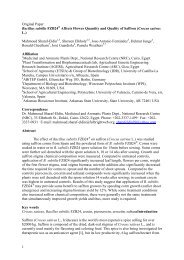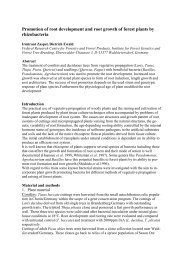Bacillus amyloliquefaciens - ABiTEP GmbH
Bacillus amyloliquefaciens - ABiTEP GmbH
Bacillus amyloliquefaciens - ABiTEP GmbH
You also want an ePaper? Increase the reach of your titles
YUMPU automatically turns print PDFs into web optimized ePapers that Google loves.
VOL. 186, 2004 BACILLUS LIPOPEPTIDES 1095<br />
to the phages, the IS elements present in B. <strong>amyloliquefaciens</strong><br />
FZB42 may also be involved in events of horizontal gene transfer.<br />
The most striking property of the genome of FZB42 is that<br />
a significant part of the genome (�7.5%, 306 kb, organized in<br />
six operons) is devoted to the biosynthesis of polyketides and<br />
peptides, enabling this bacterium to cope with competing organisms<br />
within the plant rhizosphere. Two gene clusters encoding<br />
PKS and one large gene cluster involved in nonribosomal<br />
peptide synthesis (bmy) have been identified. The<br />
impressive genetic capacity of environmental FZB42 for the<br />
production of secondary metabolites, such as lipopeptides and<br />
polyketides, exceeds twice that of the laboratory model organisms<br />
B. subtilis 168 (37) and Streptomyces coelicolor (4) and has<br />
been until now comparable only to Streptomyces avermitilis,<br />
which is well known for its production of a wide range of<br />
secondary metabolites and in which 6.4% of the entire genome<br />
is devoted to the production of secondary metabolites (27).<br />
Strain FZB42 is naturally competent for DNA uptake and<br />
homologous recombination ideally suitable for genetic approaches<br />
in analyzing its metabolic capacity e.g., by targeted<br />
construction of mutants impaired in the synthesis of cyclic<br />
lipopeptides. Here we demonstrated that disruption of one of<br />
the bmy, fen, and srf genes prevented production of the respective<br />
lipopeptides, providing evidence that these gene clusters<br />
are involved in their biosynthesis. A double mutant that was<br />
unable to produce bacillomycin D and fengycin retained its<br />
antibacterial activity directed against Streptomyces spp. but did<br />
not develop antifungal activity, suggesting that both lipopeptides<br />
might act synergistically in order to intensify suppression<br />
of fungal growth. A phenomenon until now only described in<br />
actinomycetes. Microcosm experiments with wild-type and mutant<br />
strains are necessary to clarify role of the cyclic lipopeptides<br />
in biocontrol function within plant rhizosphere.<br />
The present study characterized the production of the three<br />
cyclic lipopeptides surfactin, fengycin, and bacillomycin D by<br />
B. <strong>amyloliquefaciens</strong> FZB42. The sequence obtained for the<br />
first time for a gene cluster involved in bacillomycin D biosynthesis<br />
reflects perfectly colinearity in nonribosomal PKS domain<br />
order and its peptide synthesis function. Adenylation<br />
domains specifying amino acids different from other iturin-like<br />
peptides displayed a high degree of variability, but their functional<br />
amino acids lining the substrate binding pocket matched<br />
perfectly with the known selectivity code of the respective<br />
amino acids compiled for NRPS (4, 31). The description of the<br />
putative polyketide products directed by the three gene clusters<br />
pks1, pks2, and pks3 awaits further investigation.<br />
ACKNOWLEDGMENTS<br />
This study was done within the GenoMik program of the BMBF, the<br />
German ministry for education and research.<br />
We thank the Göttingen Genomics Laboratory and especially G.<br />
Gottschalk for continuous support of this project. We are very grateful<br />
to M. Meixner, B. Krebs, and B. Hoeding from FZB Berlin for advice<br />
and support in performing the SSH experiments and biological activity<br />
tests. We are indebted to Nicolas Grammel and Ariane Zwintscher of<br />
the ActinoDrug <strong>GmbH</strong> for the intensive cooperation in MALDI-<br />
TOF-MS analysis. We also thank Steffen Porwollik, San Diego, Calif.,<br />
and the unknown referees for improving the manuscript by many<br />
corrections and suggestions.<br />
REFERENCES<br />
1. Akopyants, N. S., A. Fradkov, L. Diatchenko, J. E. Hill, P. D. Siebert, S. A.<br />
Lukyanov, E. D. Sverdlov, and D. E. Berg. 1998. PCR-based subtractive<br />
hybridization and differences in gene content among strains of Helicobacter<br />
pylori. Proc. Natl. Acad. Sci. USA 95:13108–13113.<br />
2. Asaka, O., and M. Shoda. 1996. Biocontrol of Rhizoctonia solani damping-off<br />
of tomato with <strong>Bacillus</strong> subtilis RB14. Appl. Environ. Microbiol. 62:4081–<br />
4085.<br />
3. Ceglowski, P., and J. C. Alonso. 1994. Gene organization of the Streptococcus<br />
pyogenes plasmid pDB101: sequence analysis of the ORF eta-copS region.<br />
Gene 145:33–39.<br />
4. Challis, G. L., J. Ravel, and C. A. Townsend. 2000. Predictive, structurebased<br />
model of amino acid recognition by nonribosomal peptide synthetase<br />
adenylation domains. Chem. Biol. 7:211–224.<br />
5. Challis, G. L., and D. A. Hopwood. 2003. Synergy and contingency as driving<br />
forces for the evolution of multiple secondary metabolite production by<br />
Streptomyces species. Proc. Natl. Acad. Sci. USA 100(Suppl. 2):14555–14561.<br />
6. Chen, C.-L., L.-K. Chang, Y.-S. Chang, S.-T. Liu, and J. S.-M. Tschen. 1995.<br />
Transposon mutagenesis and cloning of the genes encoding the enzymes of<br />
fengycin biosynthesis in <strong>Bacillus</strong> subtilis. Mol. Gen. Genet. 248:121–125.<br />
7. Cutting, S. M., and P. B. van der Horn. 1990. Genetic analysis, p. 27–74. In<br />
C. R. Harwood and S. M. Cutting (ed.), Molecular biological methods for<br />
<strong>Bacillus</strong>. Wiley Interscience, Chichester, United Kingdom.<br />
8. Diatchenko, L., Y.-F. Ch. Lau, A. P. Campbell, A. Chenchik, F. Moqadam, B.<br />
Huang, S. Lukyanov, K. Lukyanov, N. Gurskaya, E. D. Sverdlov, and P. D.<br />
Siebert. 1996. Suppression subtractive hybridization: a method for generating<br />
differentially regulated or tissue-specific cDNA probes and libraries.<br />
Proc. Natl. Acad. Sci. USA 93:6025–6030.<br />
9. Duitman, E. H., L. W. Hamoen, M. Rembold, G. Venema, H. Seitz, W.<br />
Saenger, F. Bernhard, R. Reinhardt, M. Schmidt, C. Ulrich, T. Stein, F.<br />
Leenders, and J. Vater. 1999. The mycosubtilin synthetase of <strong>Bacillus</strong> subtilis<br />
ATCC 6633: a multifunctional hybrid between a peptide synthetase, an<br />
amino transferase, and a fatty acid synthase. Proc. Natl. Acad. Sci. USA<br />
96:13294–13299.<br />
10. Ebata, M., K. Miyazaki, and Y. Takahashi. 1969. Studies on subsporin. I.<br />
Isolation and characterization of subsporins A, B, and C. J. Antibiot. 22:<br />
467–472.<br />
11. Ewing, B., L. Hillier, and P. Green. 1998. Base-calling of automated sequencer<br />
traces using phred. 1. Accuracy assessment. Genome Res. 8:175–<br />
185.<br />
12. Idriss, E. S. E., O. Makarewicz, A. Farouk, K. Rosner, R. Greiner, H.<br />
Bochow, T. Richter, and R. Borriss. 2002. Extracellular phytase activity of<br />
<strong>Bacillus</strong> <strong>amyloliquefaciens</strong> FZB45 contributes to its plant-growth-promoting<br />
effect. Microbiology 148:2097–2109.<br />
13. Kallow, W., M. Pavela-Vrancic, R. Dieckmann, and H. von Döhren. 2002.<br />
Nonribosomal peptide synthetases: evidence for a second ATP binding site.<br />
Biochim. Biophys. Acta 1601:93–99.<br />
14. Krebs, B., B. Höding, S. M. Kübart, A. Workie, H. Junge, G.<br />
Schmiedeknecht, P. Grosch, H. Bochow, and M. Heves. 1998. Use of <strong>Bacillus</strong><br />
subtilis as biocontrol agent. 1. Activities and characterization of <strong>Bacillus</strong><br />
subtilis strains. J. Plant Dis. Prot. 105:181–197.<br />
15. Kunst, F., and G. Rapoport. 1995. Salt stress is an environmental signal<br />
affecting degradative enzyme synthesis in <strong>Bacillus</strong> subtilis. J. Bacteriol. 177:<br />
2403–2407.<br />
16. Kunst, F., N. Ogasawara, I. Moszer, et al. 1997. The complete genome<br />
sequence of the gram-positive bacterium <strong>Bacillus</strong> subtilis. Nature 390:249–<br />
256.<br />
17. Laland, S. G., and T. L. Zimmer. 1973. The protein thiotemplate mechanism<br />
of synthesis for the peptide antibiotics produced by <strong>Bacillus</strong> brevis. Essays<br />
Biochem. 9:31–57.<br />
18. Landy, M., G. H. Warren, S. B. Roseman, and L. G. Colio. 1948. Bacillomycin,<br />
an antibiotic from <strong>Bacillus</strong> subtilis active against pathogenic fungi.<br />
Proc. Soc. Exp. Biol. Med. 67:539–541.<br />
19. Lapidus, A., N. Galleron, J. T. Andersen, P. L. Jorgensen, S. D. Ehrlich, and<br />
A. Sorokin. 2002. Co-linear scaffold of the <strong>Bacillus</strong> licheniformis and <strong>Bacillus</strong><br />
subtilis genomes and its use to compare their competence genes. FEMS<br />
Microbiol. Lett. 209:23–30.<br />
20. Leenders, F., T. H. Stein, B. Kablitz, P. Franke, and J. Vater. 1999. Rapid<br />
typing of <strong>Bacillus</strong> subtilis strains by their secondary metabolites using matrixassisted<br />
laser desorption/ionisation mass spectrometry of intact cells. Rapid<br />
Commun. Mass Spectrom. 13:943–949.<br />
21. Maget-Dana, R., and F. Peypoux. 1994. Iturins, a special class of poreforming<br />
lipopeptides: biological and physicochemical properties. Toxicology<br />
87:151–174.<br />
22. Mahillon, J., R. Rezsohazy, B. Hallet, and J. Delcour. 1994. IS231 and other<br />
<strong>Bacillus</strong> thuringiensis transposable elements: a review. Genetica 93:13–26.<br />
23. Mootz, H. D., R. Finking, and M. Marahiel. 2001. 4�-Phosphopantetheine<br />
transfer in primary and secondary metabolism of <strong>Bacillus</strong> subtilis. J. Biol.<br />
Chem. 276:37289–37298.<br />
24. Moyne, A.-L., R. Shelby, T. E. Cleveland, and S. Tuzun. 2001. Bacillomycin





